Back to top: Ceramics
Methodology and corpus
All ceramic sherds from Tell Mozan are processed according to a standardised procedure in the field, and analysed based on a specific set of typological criteria, supervised by Marilyn Kelly-Buccellati.
A total of 17,257 sherds are included in the ceramic analysis of J6. Of these, 3655 are shape sherds (i.e., diagnostic herds), and 13,602 are body sherds. These come from 271 q-lots. The individual sherds for J6 can be found in the righthand menu under qp pottery. In addition to the qp sherds, there are a number of ceramic items and q-items from J6; there about a dozen or so in total of these, not included in the statistics presented here.
For post-excavation analysis, review and digitisation, please see below section J6 ceramic review.
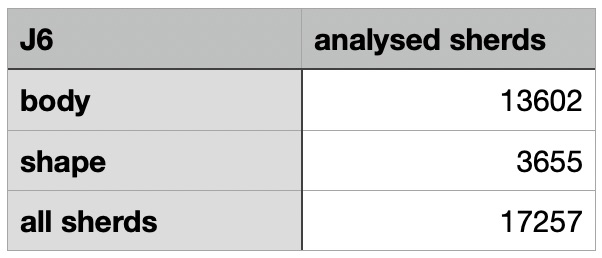
Back to top: Ceramics
Chronology
J6 stretches from Phase 3 (ED III) to Phase 8 (Middle Assyrian) in its stratigraphic assignments (in addition to topsoil and disturbed material, Phase 9). However, the main periods, as typical for area J, are ED III, overlaid by signicant Mittani-period strata.
An overview of the J6 phases can be found here, and the chronological framework here.
The ceramic assemblage reflects the intensity of the use of the area in Phase 3 and 7:
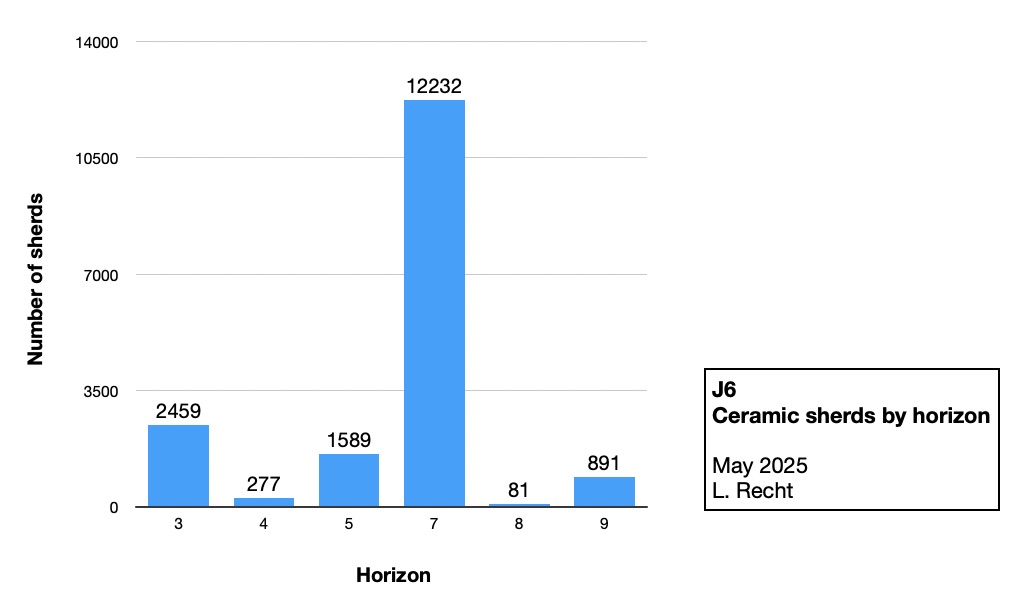
The presence of any ceramics from the intermediate Phases 4 and 5 is unusual in the area, as such seem to generally either not have been present, or cleared by activities in the Mittani period.
We can also take note of the distribution of ceramics within Phase 3 and Phase 7 strata:
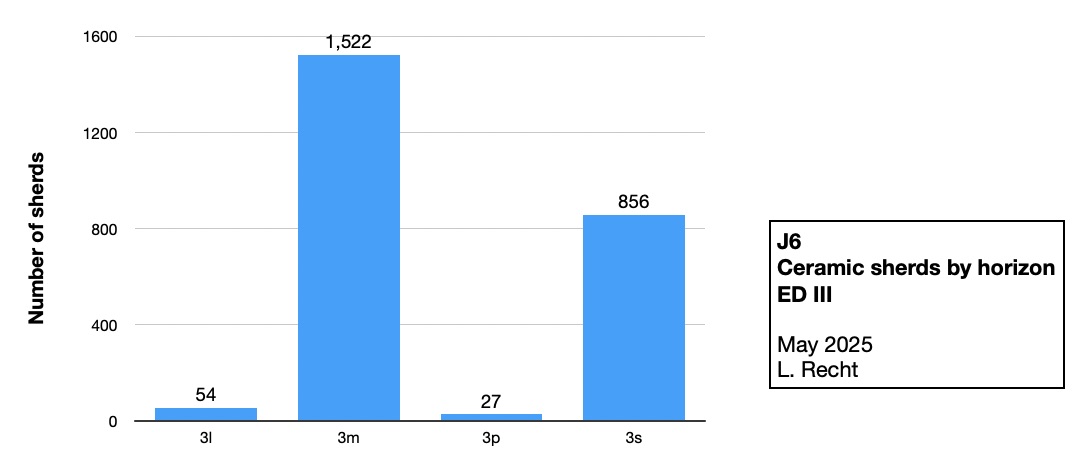
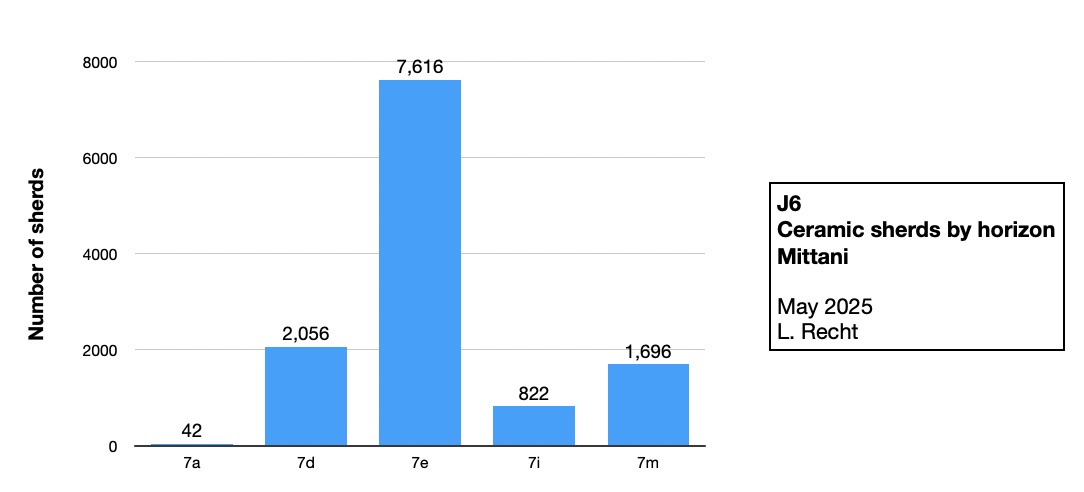
In Phase 3, the sherds mainly come from h3m and h3s strata - that is ED IIIa and ED IIIb, respectively. In Phase 7, they instead cluster in h7e, Middle Mittani stratum. The sherds from Phase 4 all come from h4m (Late Akkadian), Phase 5 sherds from h5h (Isin-Larsa), and the very few Phase 8 sherds from h8r (Middle Assyrian).
Back to top: Ceramics
Wares
As is typical for Tell Mozan, the most common ware in J6 is Chaff Temper Ware (CH). This is perhaps even more pronounced in J6 than usual, with Chaff Temper Ware making up over 60% of the overall assemblage. This is a pattern repeated in all the represented phases, where it is only in Phase 3 that it decreases to just below 50%. The ware’s popularity is only further exacerbated when we include its finer version, Fine Chaff Temper Ware (FC), which is the second-most common type, in every period. Red Orange Calcite Temper Ware (RC) and Pebble Temper Ware (P) follow, also with a significant number of sherds, with lower amounts of Wet Smooth Ware (WS), Rough Ware (R), Fine Red Orange Calcite Ware (RC1), and Simple Ware (S). Wet Smooth Ware, Simple Ware and Rough Ware were common in the ED III period, and they naturally make up higher proportions of the Phase 3 assemblage.
There are a few examples of imports in the form of Metallic Ware (M) and its imitations, Imitation Metallic Ware (IM) and Dark Brick Red Ware (DBR), along small amounts of Gray Ware (G).
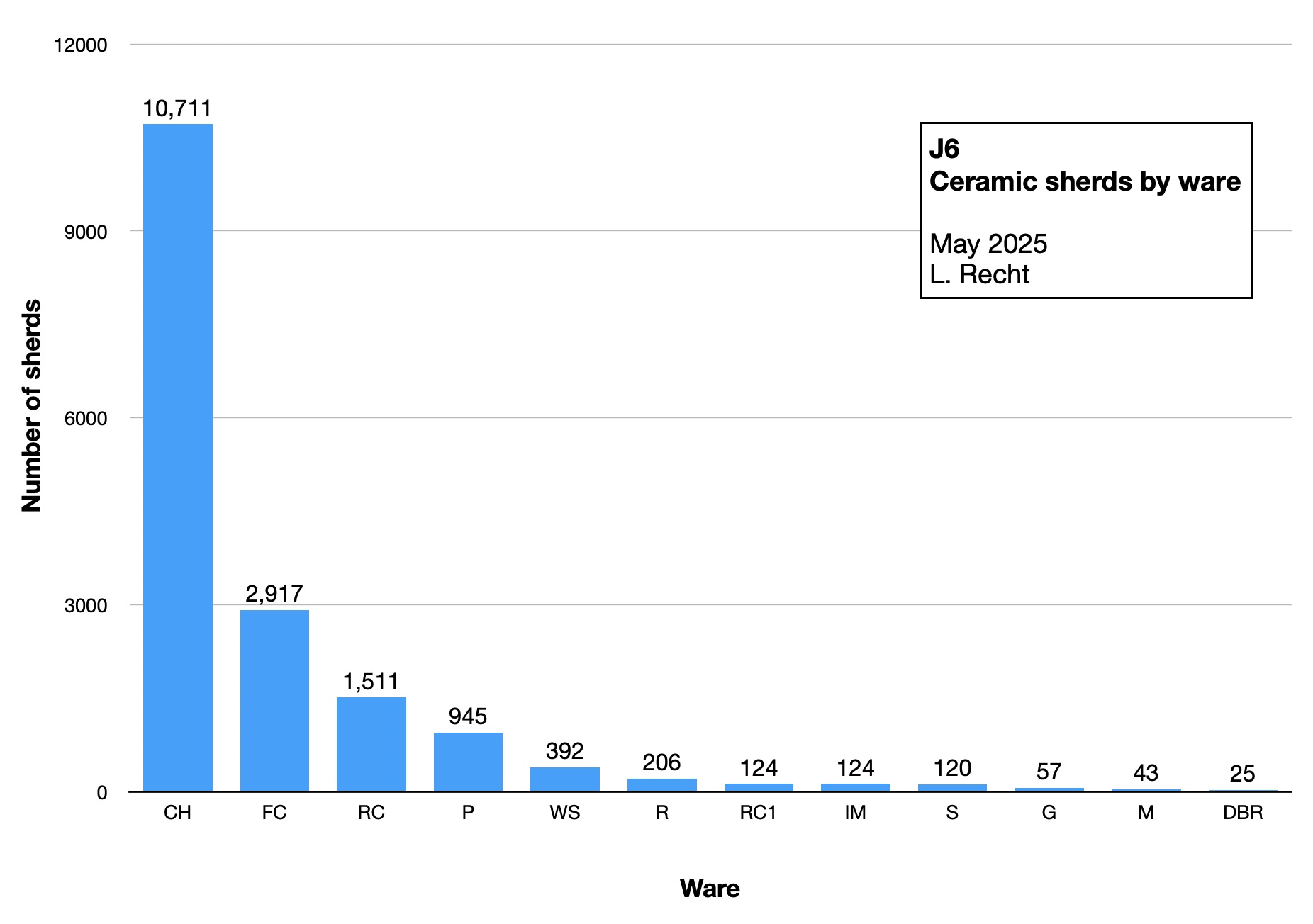
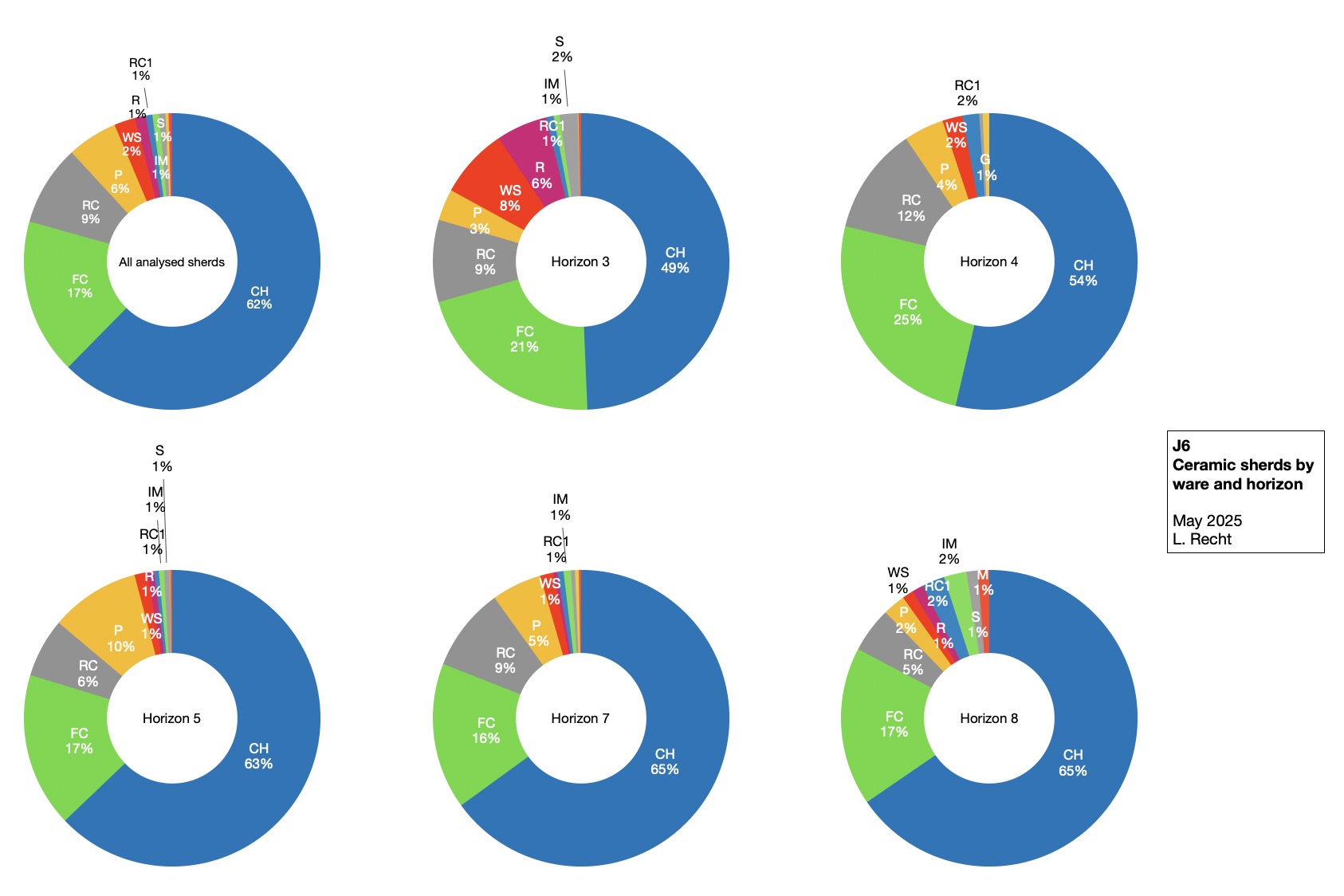
Note on charts: wares with fewer than a total of 10 sherds have not been included here:
Bi-Color Ware (BC): 4;
Fine Pebble Temper Ware (FP): 6;
Khabur Ware (H): 7;
Late Chalcolithic Chaff Temper Ware (LCH): 2;
Ninevite 5 Ware (NIN): 1.
Back to top: Ceramics
Shapes
The overall ceramic assemblage demonstrates a slight majority of closed vessels (jars) over open vessels (bowls, cups, plates), in all periods. Jars were primarily used for storage and pouring, while bowls, cups and plates usually serve as tableware. Of the main shapes, jars are the most common, followed by bowls. Fewer cups, pots, plates, stands, bottles and strainers make up the rest of the assemblage, along with worked disks, which are not themselves a vessel type, but ceramic sherds that were reused as a stopper.
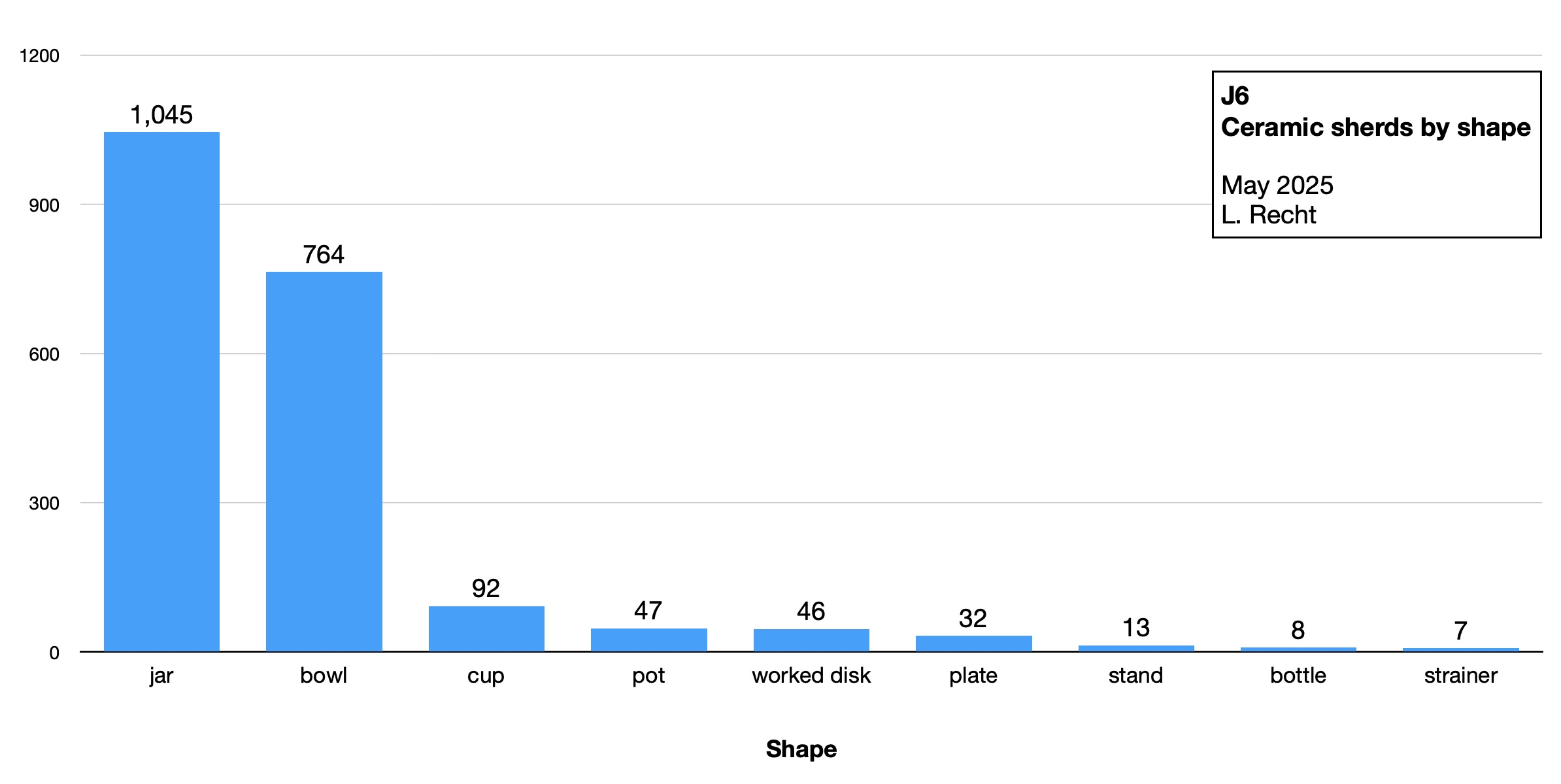
The distribution of the main shapes is fairly stable through the different phases, with fluctuations mainly occurring in shapes such as pots, strainers and bottles:
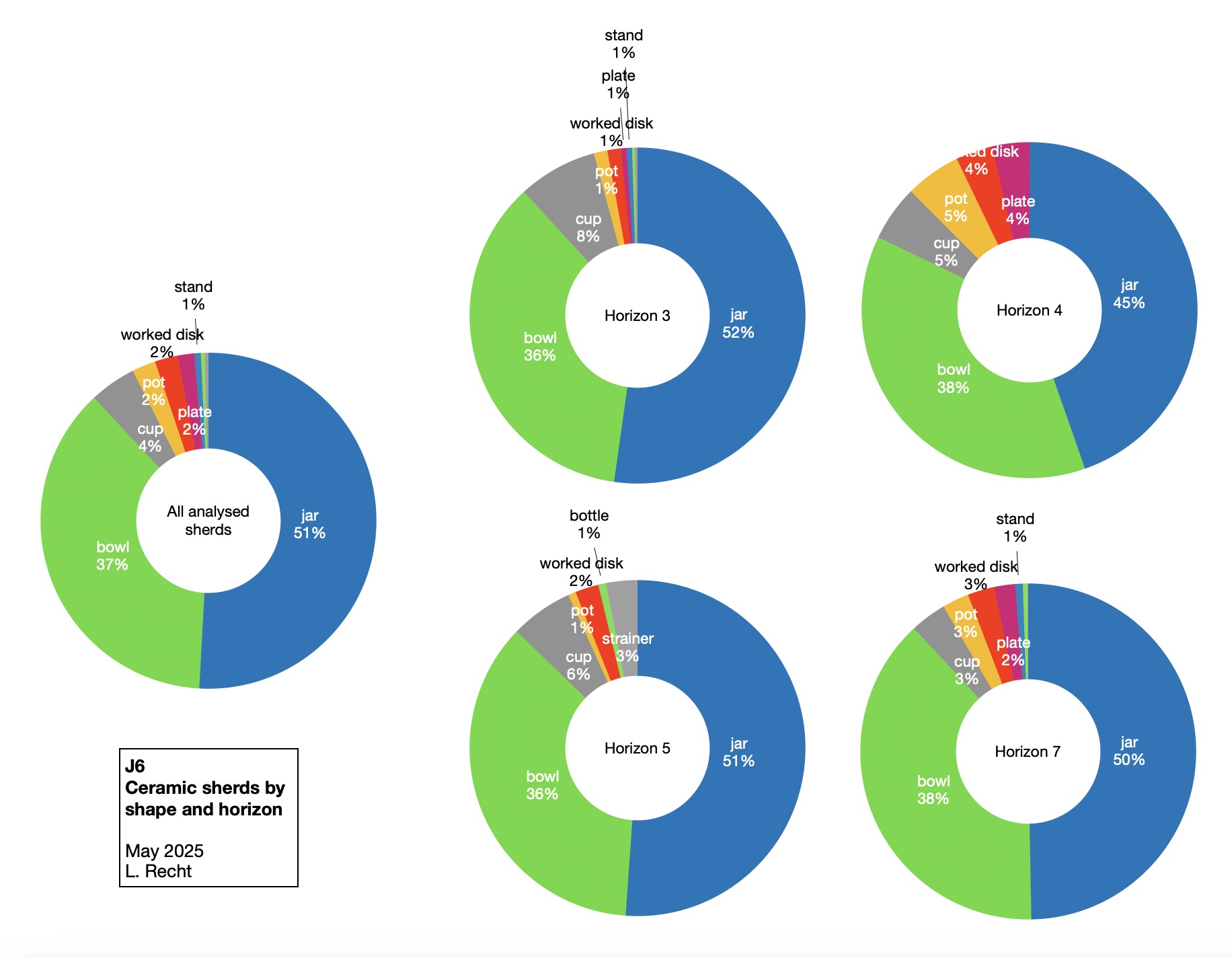
Greater variation can be noted when examining the sub-shapes in each period, especially in the jars and bowls:
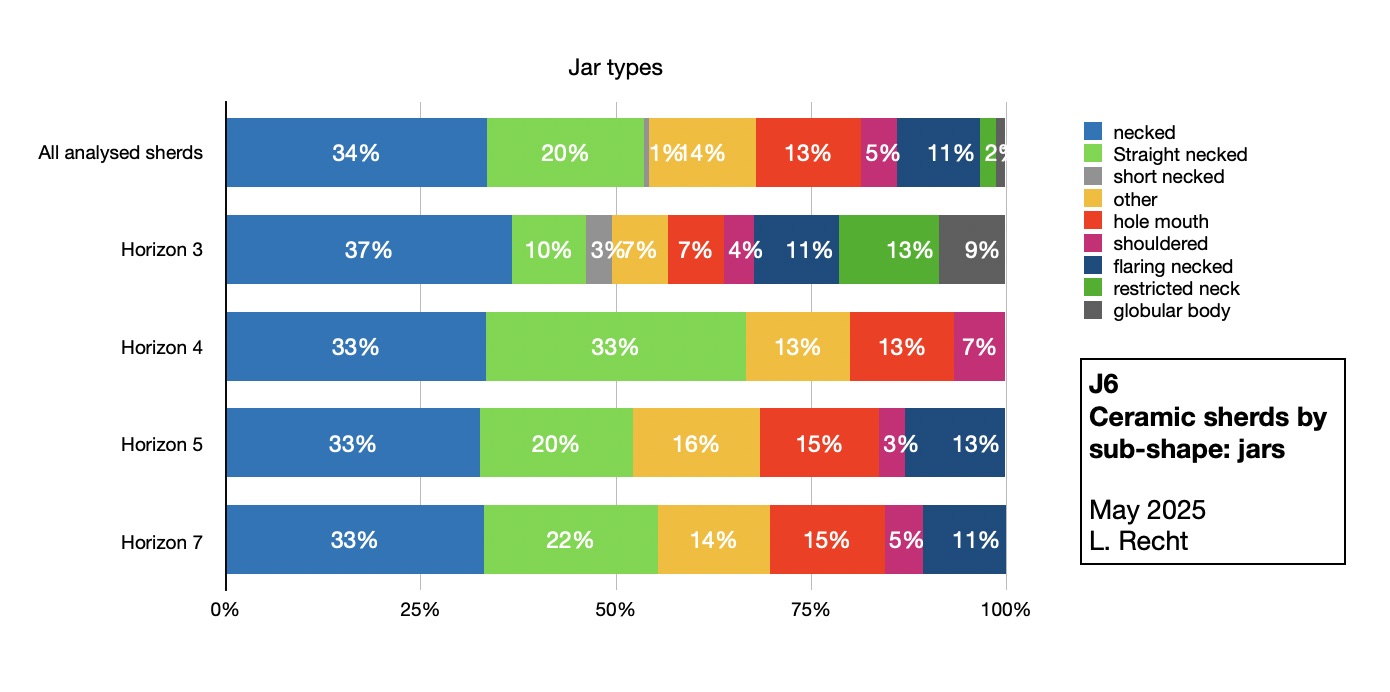
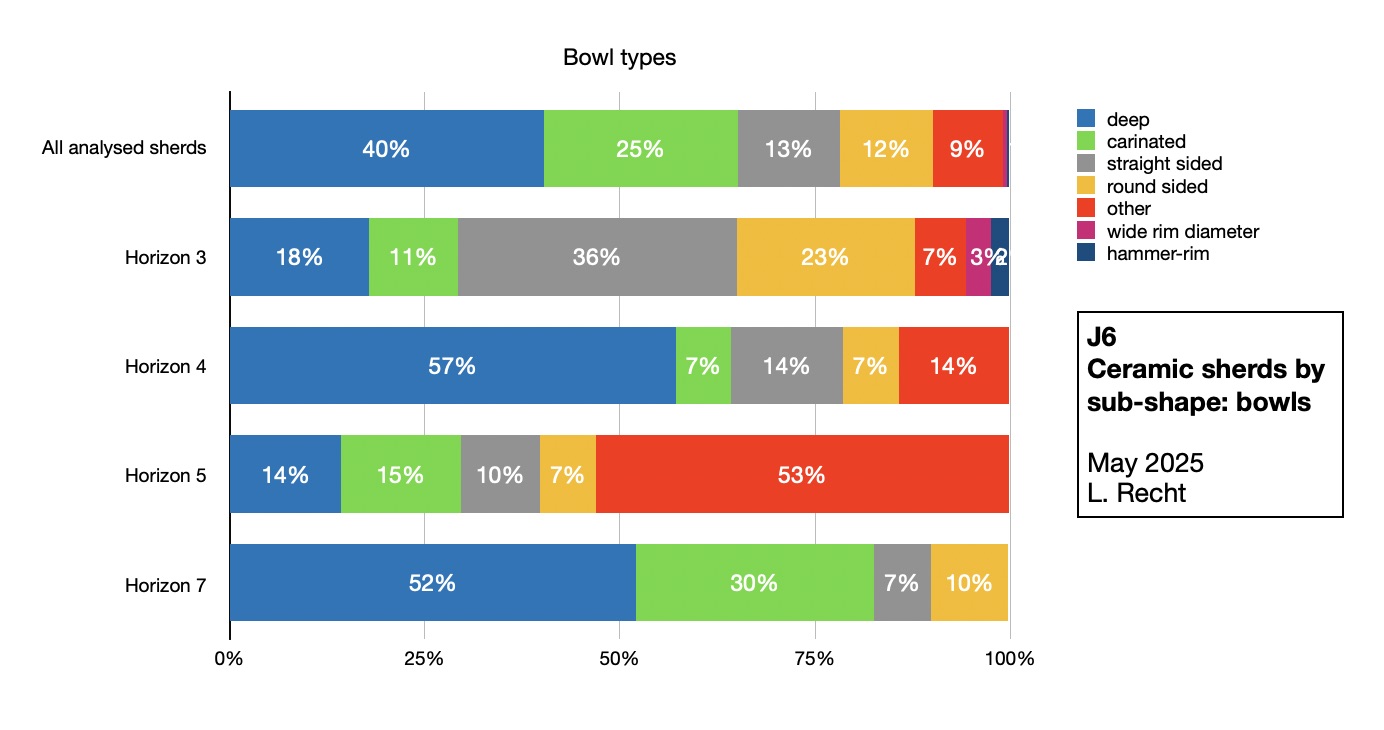
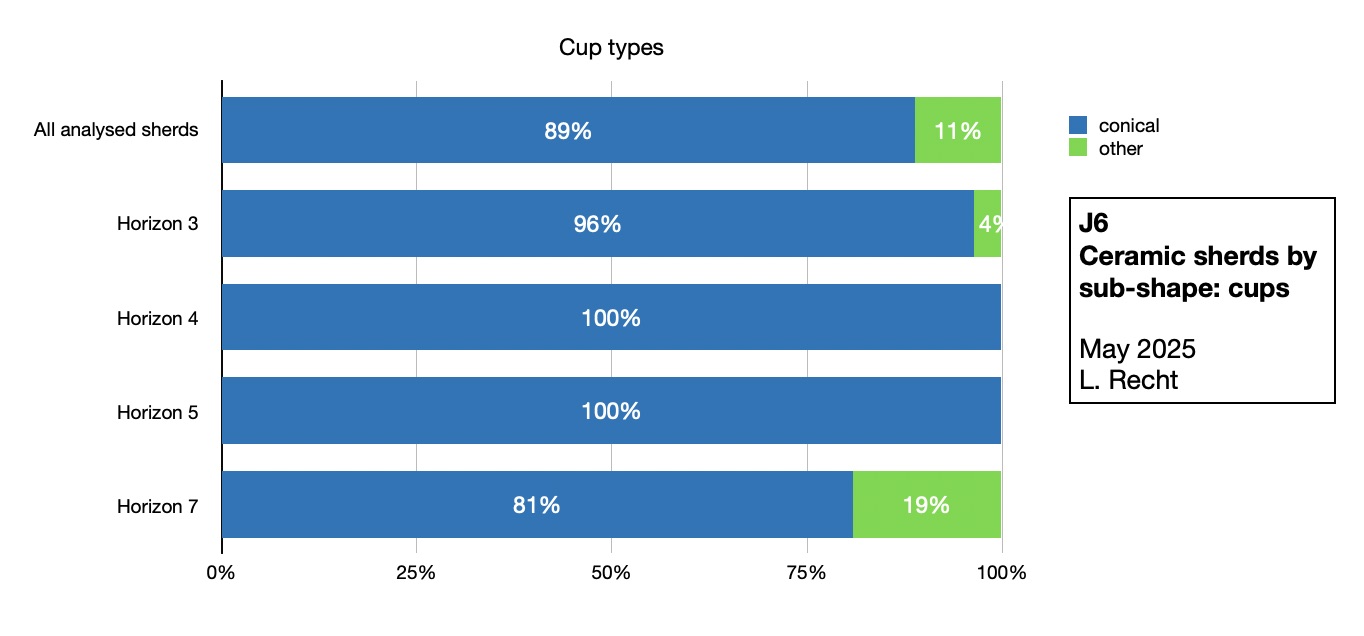
Thus, we can see that, while necked jars are popular in all periods, the sub-type varies. This is even more marked in the bowl types, where straight sided and round sided types (fairly open types) were preferred in Phase 3, while deep bowls (a shape less open and suitable as tableware) and carinated bowls (ideal serving vessels) were preferred in Phase 7. Further variations occur in the intermediate periods, but one must be wary of the relatively small number of diagnostic sherds from these phases.
Note on charts: Phase/Horizon 8 is not included as a separate chart here, since the total number of diagnostic sherds (16) is too small to yield meaningful results. The total diagnostic sherds of the other phases are as follows: Horizon 3: 381; Horizon 4: 56; Horizon 5: 133; Horizon 7: 1352.
Back to top: Ceramics
Complete vessels
Only a few complete vessels come from J6, all of which are small or miniature.
Back to top: Ceramics
Small vessels (Patrizia Camatta)
There is a series of small vessels, probably used for perfumes or powders, found in the brickfall or in the fill of a pit. All of them are out of their original context.
|
J6.3 is a small jar with a globular body. Inside was found a brown soft soil with small shells and bones. The small jar was found in the upper portion of the brickfall.
|
|
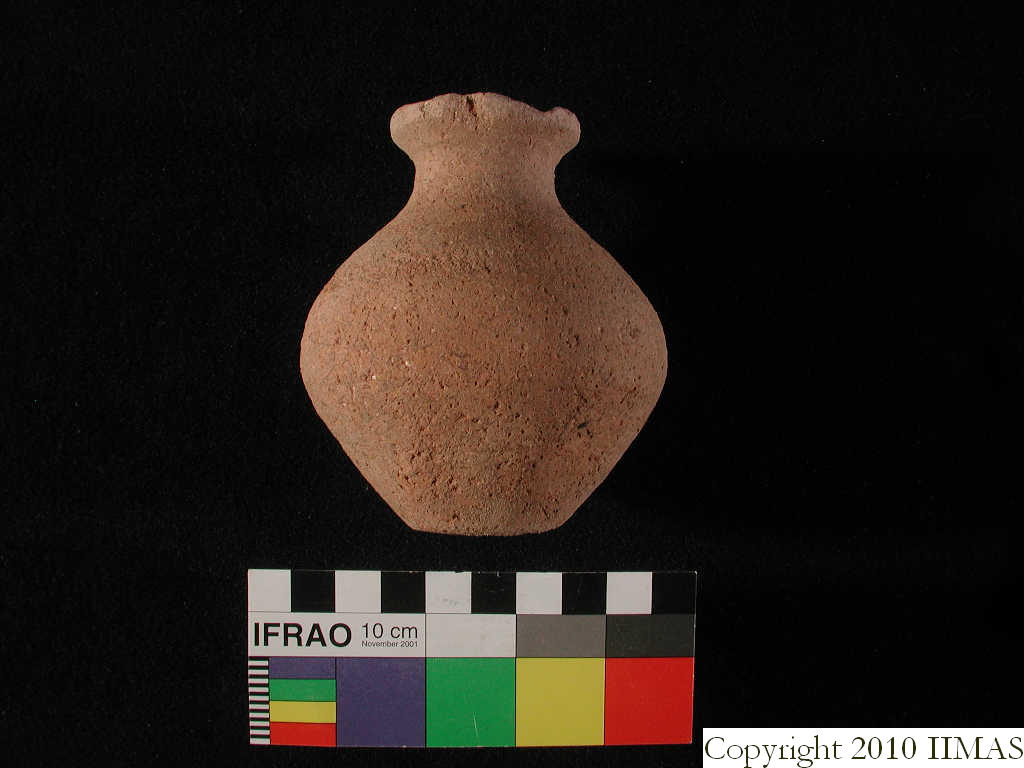 |
|
J6.11 is a tiny handmade globular jar. It was found in the fill of a pit together with many ceramic sherds and animal bones in f142.
|
|
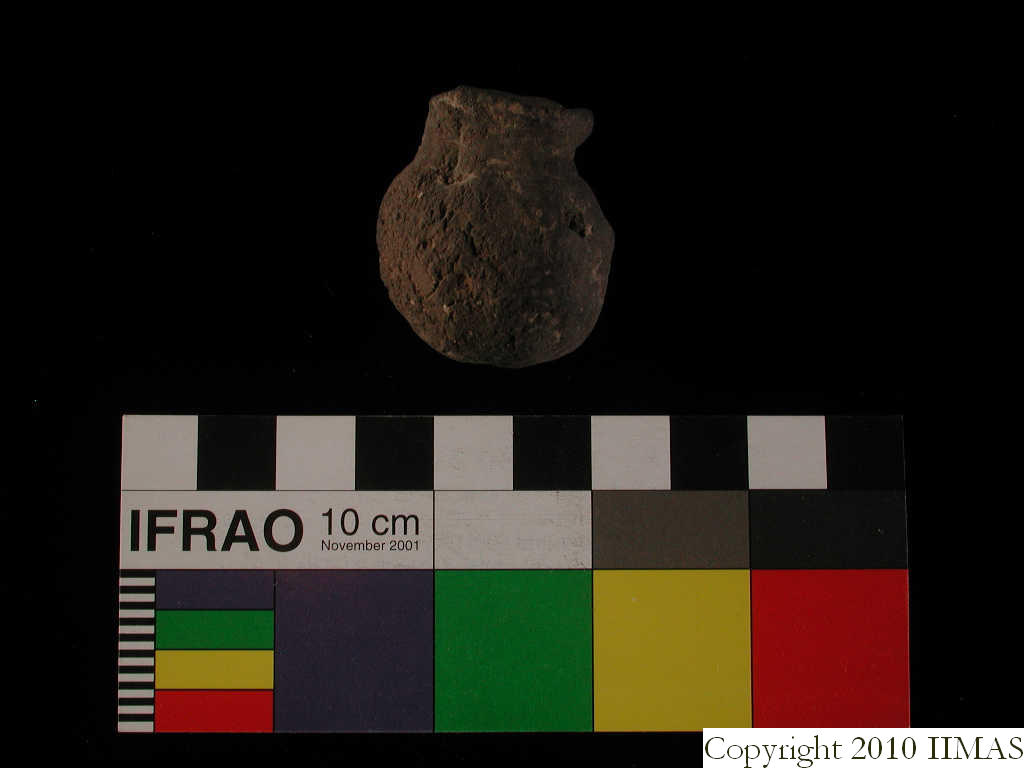 |
|
J6.13 is a small cup decorated with incised lines painted in black and red. The cup was found in brickfall f146.
|
|
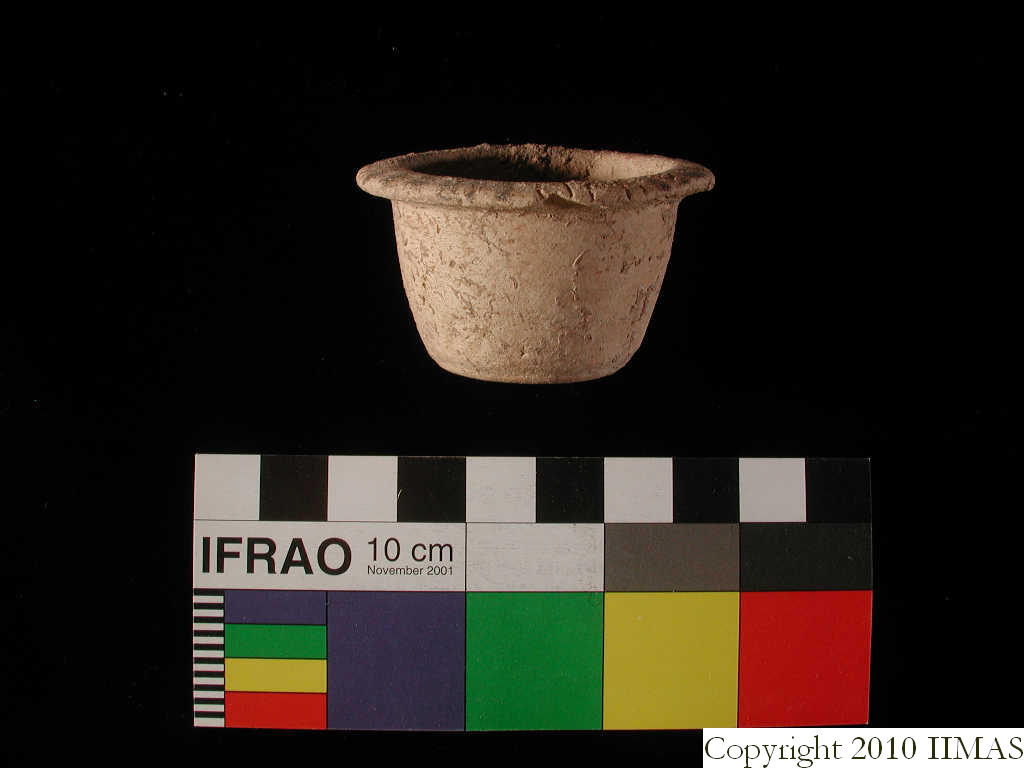 |
|
J6q121.3 is a small clay strainer. The context is unfortunately missing.
|
|
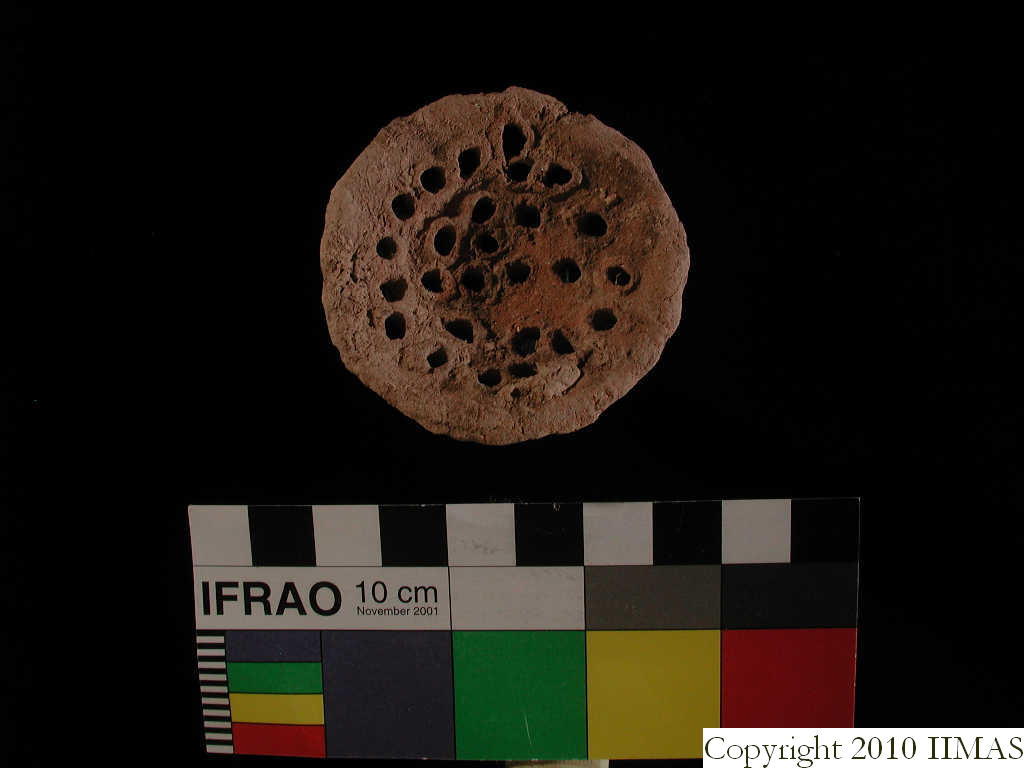 |
Back to top: Ceramics
Assemblages
TEXT TO BE WRITTEN rL ZJ525: I will add this, but first the assemblages need to be created and reviewed
Back to top: Ceramics
J6 ceramic review
All ceramics are reviewed before digital publication. The review process consists of checking the ‘cumulative’ excel sheets of all sherds, drawings and photos for consistency and correct coding. During this, sherd information and drawing may be corrected, relabelled or even removed from the record due to unsolvable errors. We aim to maintain as many records as possible, noting changes and uncertainties in the pages of the relevant q-lots or individual sherds. Where it is not possible to solve an error, sherds are removed from the official record, but kept in error files.
The J6 shape and body sherds were reviewed mainly in 2017, and finalised in 2025, by Laerke Recht. The J6 ceramic assemblage of a small to medium size. Combined with it having been excavated fairly recently, this meant that the review was less complex than with other units. Not many errors were identified, and most could easily be solved; few entries needed to be removed entirely (these are listed here).
ADD LIST OF ANALYSED SHERDS AND ERRORS LIST
Back to top: Ceramics